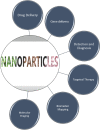Toxicology of Nanoparticles in Drug Delivery
- PMID: 34840918
- PMCID: PMC8611175
- DOI: 10.1007/s40139-021-00227-z
Toxicology of Nanoparticles in Drug Delivery
Abstract
Nanoparticles have revolutionized biomedicine especially in the field of drug delivery due to their intriguing properties such as systemic stability, level of solubility, and target site specificity. It can, however, be both beneficial and damaging depending on the properties in different environments, thus highlighting the importance of nanotoxicology studies before use in humans. Different types of nanoparticles have been used in drug delivery, and this review summarizes the recent toxicity studies of these nanoparticles. The toxicological evaluation of three widely used nanoparticles in drug delivery that are metal, lipid, and protein nanoparticles has been discussed in detail. Studies have recorded several toxic effects of various nanoparticles such as metal-based nanoparticles have been linked to increased oxidative stress and have the potential to infiltrate the cell nucleus and protein-based nanoparticles have been observed to have hepatotoxicity and nephrotoxicity as their adverse effects. Considering the increasing application of nanoparticles in drug delivery and the growing concerns of regulatory authorities regarding the toxicity of nanocarriers in living organisms, it requires urgent attention to identify the gap in toxicity studies. The review highlights the gap in toxicity studies and potential focus areas to overcome the existing challenges.
Keywords: Lipid nanoparticles; Metal nanoparticles; Nanoparticles; Nanotoxicology; Protein nanoparticles; Toxicity assessment.
© The Author(s), under exclusive licence to Springer Science+Business Media, LLC, part of Springer Nature 2021.
Conflict of interest statement
Conflict of InterestSwati Sharma, Roza Parveen, and Dr. Biswa Prasun Chatterji declare that they have no conflict of interest.
Figures
References
-
- Khana I, Saeed K, IdreesKhan. Nanoparticles: properties, applications and toxicities. Arab J Chem. 2019; 908–93. 10.1016/j.arabjc.2017.05.011.
-
- Prasad M, Lambe UP, Brar B, lShah I, et al. Nanotherapeutics: an insight into healthcare and multi-dimensional applications in the medical sector of the modern world 2018:97: 1521–1537. 10.1016/j.biopha.2017.11.026. - PubMed
Publication types
LinkOut - more resources
Full Text Sources
Miscellaneous


